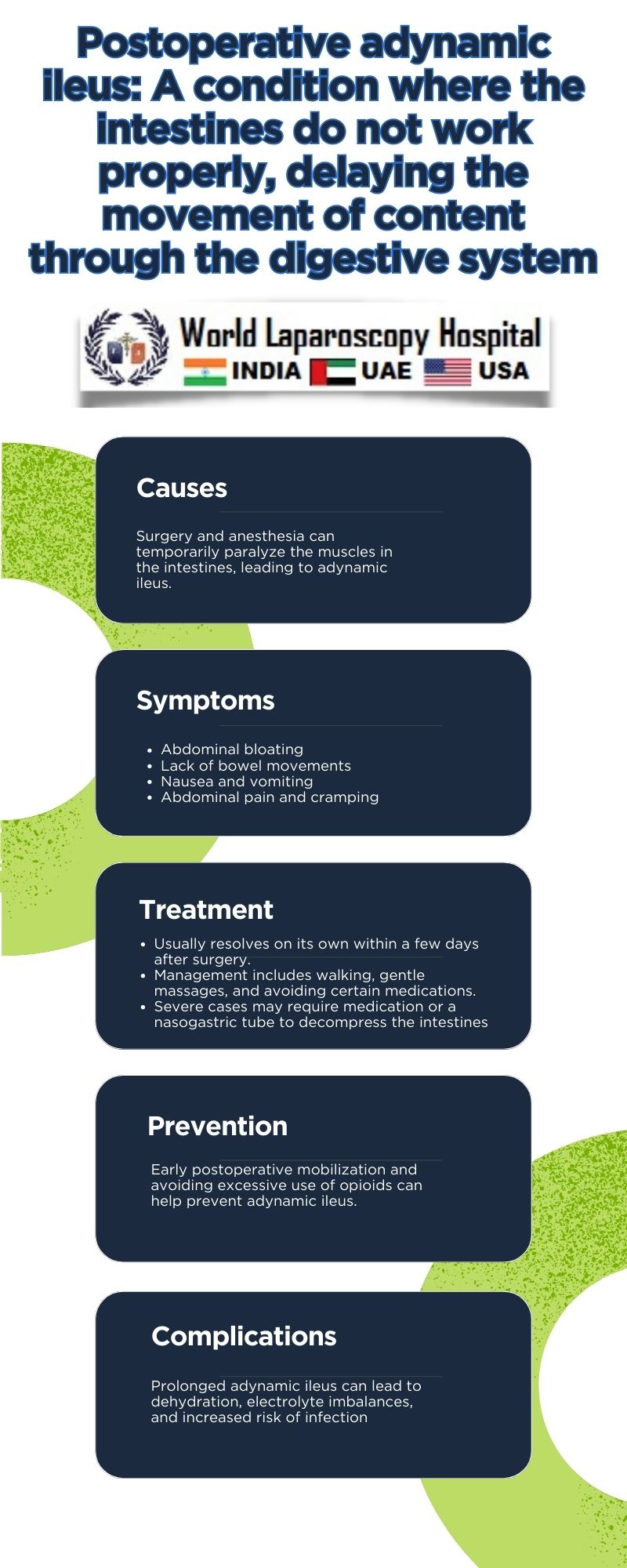Postoperative adynamic ileus: A condition where the intestines do not work properly, delaying the movement of content through the digestive system
Introduction
Postoperative adynamic ileus (POI) is a transient condition characterized by the temporary impairment of normal bowel motility following abdominal surgery. It is a common complication, affecting up to 20% of patients undergoing major abdominal procedures. POI can lead to significant morbidity, including discomfort, distension, nausea, vomiting, and delayed recovery. Understanding the pathophysiology, risk factors, clinical presentation, and management strategies for POI is essential for healthcare providers to optimize patient care and outcomes.

Pathophysiology
The pathophysiology of POI is multifactorial and not fully understood. However, several mechanisms have been proposed, including:
Neurogenic factors:
Surgical trauma and manipulation of the bowel can lead to disruption of the enteric nervous system, causing a temporary loss of normal bowel motility.
Inflammatory response:
Surgery-induced inflammation can result in the release of cytokines and other inflammatory mediators, which can impair smooth muscle function and delay gastrointestinal transit.
Pharmacological factors:
The use of opioids for pain management postoperatively can contribute to POI by inhibiting peristalsis and prolonging gastrointestinal transit time.
Fluid and electrolyte imbalance:
Surgery can lead to alterations in fluid and electrolyte balance, which can affect bowel motility and function.
Surgical factors:
The type and extent of surgery can influence the risk of developing POI. Procedures that involve extensive manipulation of the bowel or prolonged surgical times are associated with a higher risk.
Risk Factors
Several factors have been identified that increase the risk of developing POI, including:
Type and extent of surgery:
Procedures involving the manipulation of the bowel or extensive surgical dissection are associated with a higher risk of POI.
Age:
Older adults are at increased risk of developing POI due to age-related changes in bowel function and response to surgery.
Opioid use:
The use of opioids for pain management postoperatively is a significant risk factor for POI.
Inflammatory conditions:
Patients with preexisting inflammatory conditions, such as Crohn's disease or ulcerative colitis, are at increased risk of developing POI.
Diabetes:
Patients with diabetes are at higher risk of developing POI due to neuropathy and altered gastrointestinal motility.
Clinical Presentation
The clinical presentation of POI can vary but typically includes:
Abdominal distension:
Patients may experience bloating and abdominal distension due to the accumulation of gas and fluid in the intestines.
Nausea and vomiting:
Patients may experience nausea and vomiting due to delayed gastric emptying and impaired gastrointestinal motility.
Absence of bowel sounds:
On physical examination, bowel sounds may be diminished or absent due to reduced peristalsis.
Delayed passage of flatus and stool:
Patients may experience a delay in the passage of flatus and stool, which is indicative of impaired bowel motility.
Abdominal pain:
Patients may experience crampy abdominal pain due to distension and spasm of the intestines.
Diagnosis
The diagnosis of POI is primarily clinical and based on the patient's history and physical examination findings. Imaging studies, such as abdominal X-rays or CT scans, may be performed to rule out other causes of abdominal distension and pain. Laboratory tests, including complete blood count (CBC) and electrolyte levels, may be done to assess for complications of POI, such as dehydration or electrolyte imbalances.
Management
The management of POI is aimed at relieving symptoms, restoring bowel function, and preventing complications. Treatment options include:
NPO (nothing by mouth):
Patients with POI are often placed on a clear liquid or NPO diet to rest the bowel and reduce stimulation.
Intravenous fluids:
Fluids are administered intravenously to maintain hydration and correct electrolyte imbalances.
Analgesia:
Non-opioid analgesics are preferred for pain management in patients with POI to avoid further slowing of bowel motility.
Ambulation:
Early ambulation is encouraged to stimulate bowel motility and prevent complications of immobility.
Nasogastric decompression:
In severe cases of POI, a nasogastric tube may be placed to decompress the stomach and intestines and relieve symptoms.
Prokinetic agents:
Medications that stimulate gastrointestinal motility, such as metoclopramide or erythromycin, may be used to help restore normal bowel function.
Surgical intervention:
In rare cases, surgical intervention may be necessary to relieve obstruction or correct underlying anatomical abnormalities contributing to POI.
Conclusion
Postoperative adynamic ileus is a common complication following abdominal surgery, characterized by a temporary impairment of normal bowel function. The pathophysiology of POI is multifactorial, involving neurogenic, inflammatory, pharmacological, fluid and electrolyte imbalance, and surgical factors. Several risk factors increase the likelihood of developing POI, including the type and extent of surgery, age, opioid use, inflammatory conditions, and diabetes. The clinical presentation of POI includes abdominal distension, nausea, vomiting, absence of bowel sounds, delayed passage of flatus and stool, and abdominal pain. Diagnosis is primarily clinical, and management involves supportive care, including NPO, intravenous fluids, analgesia, ambulation, nasogastric decompression, prokinetic agents, and surgical intervention in severe cases. Understanding the causes, symptoms, diagnosis, and management of POI is essential for healthcare providers to effectively manage this condition and improve patient outcomes.
| Older Post | Home | Newer Post |


